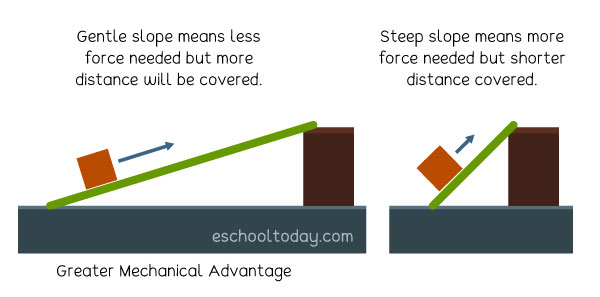Have you ever wondered how a ramp makes it easier to move heavy objects? Or how a slide allows us to descend effortlessly? These everyday examples are all powered by a fascinating and fundamental simple machine – the inclined plane.

Image: www.coursehero.com
The inclined plane is one of the six classic simple machines, alongside the lever, pulley, wheel and axle, wedge, and screw. Its seemingly simple design, a flat surface at an angle to the horizontal, holds incredible power to reduce the force needed to move objects. It’s a concept deeply embedded in our world, from the gentle slope of a driveway to the towering ramp of a construction site.
Exploring the Inclined Plane: Concepts and Applications
At its core, the inclined plane works on the principle of exchanging force for distance. This means that by increasing the distance an object travels, the force required to move it is reduced. Imagine pushing a heavy box up a ramp: you cover a longer distance, but the effort you exert is significantly less compared to lifting it directly.
The steepness of the inclined plane, known as its incline angle or slope, influences the force required. A steeper incline means less distance but greater force, while a gentler incline requires less force but a longer distance. This trade-off between force and distance is the fundamental principle of the inclined plane.
Hands-On Investigation: A Student Experiment
There’s no better way to understand a concept than to experience it firsthand. Conducting an experiment on the inclined plane allows students to see its principles in action.
Here’s a simple yet effective experiment:
Materials:
- A smooth, flat surface (like a board)
- Wooden blocks or other objects of varying weights
- A measuring tape
- A ruler
- A spring scale

Image: mungfali.com
Procedure:
- Set up the board as an inclined plane by raising one end to create a slope.
- Measure the length and height of the incline (the distance along the slope and the vertical height, respectively).
- Place a block on the surface and gently pull it upwards along the incline using the spring scale. Note the force required.
- Repeat the process with different inclined angles (raising the end of the board to different heights).
- Record the force required in each case and compare it to the weight of the block.
Observations and Analysis:
- Observe how the force required to move the block changes with the angle of the incline.
- Calculate the mechanical advantage, which is the ratio of the weight of the block to the force applied. A higher mechanical advantage means a greater force reduction.
- Based on your findings, explore the relationship between the angle of the incline, the force needed, and the distance traveled.
This experiment allows students to see firsthand how the inclined plane reduces the force required to lift an object. They can also observe the trade-off between the force and the distance traveled and develop an understanding of the concept of mechanical advantage.
Inclined Planes Everywhere: Real-World Applications
The inclined plane is far from just a classroom experiment; it’s a fundamental principle woven into many aspects of our daily lives and the world around us. Here are some common examples:
- Ramps: From ramps for wheelchairs to loading docks, ramps make it easier to move heavy loads up and down vertical distances.
- Slides: The smooth downward slope of a slide makes it fun and easy to descend, utilizing the principle of gravity.
- Wedges: A wedge, like an ax blade or a doorstop, is essentially a double inclined plane. The force applied at the thicker end creates a greater force at the thinner end, splitting or separating objects.
- Screws: A screw is an inclined plane wrapped in a spiral. The thread acts like a ramp, enabling the screw to move forward as it rotates, allowing it to penetrate materials.
- Roads and Highways: Roads and highways are built with gradual inclines to reduce the force required for vehicles to climb uphill and avoid sudden changes in speed.
- Conveyor Belts: Conveyor belts in factories and warehouses utilize inclined planes to move materials and products efficiently.
- Stairways: Stairways, despite their vertical nature, incorporate inclines to make it easier to move between floors.
The pervasiveness of the inclined plane in our lives highlights its importance in engineering, construction, and everyday tasks. It’s a testament to the power of simple machines to reduce force and make work easier.
Student Exploration Inclined Plane Simple Machine
Looking Beyond: Further Explorations
Understanding the inclined plane extends beyond simple experiments. There are abundant opportunities for deeper explorations. Students can delve into the mathematical derivation of the inclined plane’s force reduction, explore the relationship between friction and the inclined plane, or investigate the various applications of the inclined plane in advanced technologies, such as in robotic systems or prosthetic devices.
The inclined plane, though seemingly simple, offers a vast and exciting world of exploration for eager minds. By exploring its principles, students can gain a deeper understanding of how our world works, inspiring them to create and innovate by applying its principles to everyday challenges.






